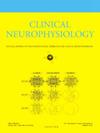重性抑郁症的异常非线性脑-心相互作用:静息状态脑电图和心电图的证据
IF 3.6
3区 医学
Q1 CLINICAL NEUROLOGY
引用次数: 0
摘要
目的重度抑郁症(MDD)破坏了大脑和心脏之间的相互作用,但其潜在机制尚不清楚。本研究旨在从非线性角度探讨重度抑郁症的异常非线性脑-心相互作用。方法记录38例重度抑郁症患者和32例健康对照者的睡眠状态脑电图和心电信号。采用收敛交叉映射(CCM)研究脑电振荡与心率变异性(HRV)之间的双向相互作用。Pearson相关性评估异常脑-心相互作用与临床症状之间的关系。特征排序确定了重度抑郁症的关键脑-心相互作用特征。结果smdd患者在高δ和θ波段的心脑相互作用明显减弱,表明自下而上的内感受信息流中断。心-高δ交互作用与HAMD-24评分呈负相关(r = -0.500, p = 0.008),将心-脑交互作用受损与抑郁症严重程度联系起来。HRV对照分析证实,心脏-高δ相互作用的损害与抑郁严重程度有关,而与自主神经功能障碍无关。特征排序强调了心脑相互作用在低频脑电图振荡中的关键作用。结论心脑相互作用异常在抑郁症的病理生理中起重要作用。这些发现突出了脑-心动力学在重度抑郁症中的重要性,并为其潜在的生理机制提供了新的见解。本文章由计算机程序翻译,如有差异,请以英文原文为准。
Abnormal nonlinear Brain-Heart interactions in major depressive disorder: Evidence from Resting-State EEG and ECG
Objective
Major depressive disorder (MDD) disrupts the interactions between the brain and heart, yet the underlying mechanisms remain poorly understood. This study aims to investigate the abnormal nonlinear brain–heart interactions in MDD from a nonlinear perspective.
Method
Resting-state EEG and ECG signals were recorded from 38 MDD patients and 32 healthy controls. Convergent cross mapping (CCM) was used to explore the bidirectional interactions between EEG oscillations and heart rate variability (HRV). Pearson correlation assessed the relationship between abnormal brain–heart interactions and clinical symptoms. Feature ranking identified the key brain–heart interactions features for MDD.
Results
MDD patients showed significantly attenuated heart-to-brain interactions in the high δ and θ bands, indicating a disrupted bottom-up interoceptive information flow. Heart-to-high δ interaction negatively correlated with the HAMD-24 score (r = -0.500, p = 0.008), linking impaired heart-to-brain interactions with depression severity. HRV control analysis confirmed that the impairment in heart-to-high δ interactions was associated to depression severity, not to autonomic dysfunction. Feature ranking emphasized the critical role of heart-to-brain interactions in low-frequency EEG oscillations.
Conclusion
Abnormal heart-to-brain interactions play a substantial role in the pathophysiology of depression.
Significance
These findings highlight the importance of brain–heart dynamics in MDD and provide new insights into its underlying physiological mechanisms.
求助全文
通过发布文献求助,成功后即可免费获取论文全文。
去求助
来源期刊

Clinical Neurophysiology
医学-临床神经学
CiteScore
8.70
自引率
6.40%
发文量
932
审稿时长
59 days
期刊介绍:
As of January 1999, The journal Electroencephalography and Clinical Neurophysiology, and its two sections Electromyography and Motor Control and Evoked Potentials have amalgamated to become this journal - Clinical Neurophysiology.
Clinical Neurophysiology is the official journal of the International Federation of Clinical Neurophysiology, the Brazilian Society of Clinical Neurophysiology, the Czech Society of Clinical Neurophysiology, the Italian Clinical Neurophysiology Society and the International Society of Intraoperative Neurophysiology.The journal is dedicated to fostering research and disseminating information on all aspects of both normal and abnormal functioning of the nervous system. The key aim of the publication is to disseminate scholarly reports on the pathophysiology underlying diseases of the central and peripheral nervous system of human patients. Clinical trials that use neurophysiological measures to document change are encouraged, as are manuscripts reporting data on integrated neuroimaging of central nervous function including, but not limited to, functional MRI, MEG, EEG, PET and other neuroimaging modalities.
 求助内容:
求助内容: 应助结果提醒方式:
应助结果提醒方式:


